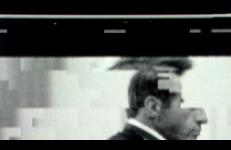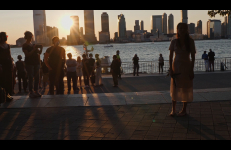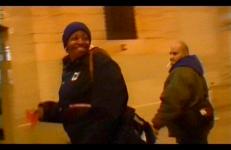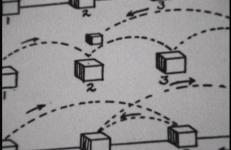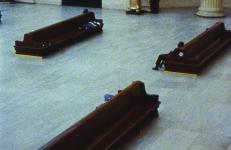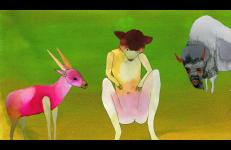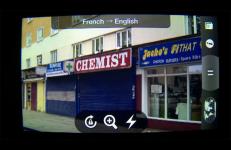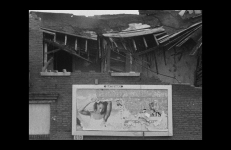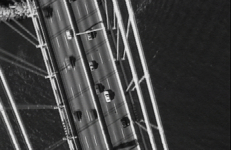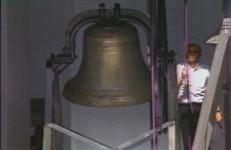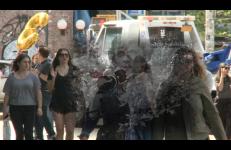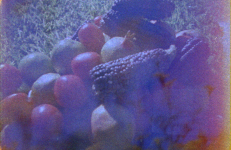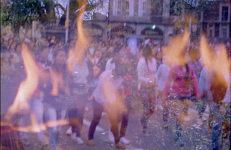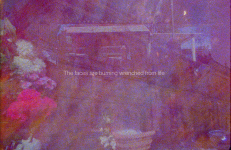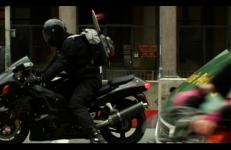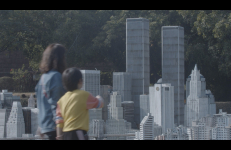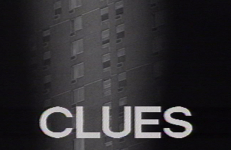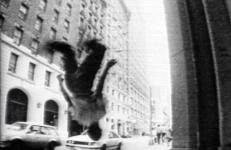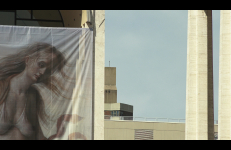Parry Teasdale, David Cort and Chuck Kennedy visit The Kitchen in New York looking for Shirley Clarke, and bump into Steina and Woody Vasulka who are overseeing a show in progress. A few doors down they find Shirley in her studio, dressed in white and full of energy.
City
"There are three scenes in this work, all reflecting a changing sense of time. Each has a voiceover soundtrack with a similar structure, but with different information. Some of the comments presume that the viewer is privy to information which is never given..."
An homage to Chicago's East 95th Street Bridge, Calumet Fisheries and to a couple of the city's infamous brothers. The take-out shack, originally glimpsed in the background of a scene from The Blues Brothers, still operates. It has become a real-world portal to a cinematic past. Propped along the edge of the 95th street drawbridge, the building is framed by the towering infrastructures of the Chicago Skyway and Calumet Harbor.
On September 11, 2021, Eiko Otake performed at 7am and 6pm at Belvedere Plaza in Battery Park City by the Hudson River, directly west of where the Twin Towers once stood. This video work is from the 6pm performance.
On a snow-covered New Year's Day in New York City, Snow (I Wish There Was Cars) captures a city at a standstill: children sled, wind whips snow over empty streets, and New Yorkers search for warmth in a deserted urban landscape.
Shot by Parry Teasdale in 1971, with music also by Teasdale.
During my residency in New York I was designing a computer virus, which would contaminate computers through a screensaver that read “there is so much love in this world”. In the meanwhile, inspired by the illusionary democratic representation system in the United States and triggered by the indifference of the New York public to the presidential campaign, I went out to the streets to distribute fliers that carried this virus sentence. People of New York reacted in different ways to this action, which had similarities with many other hand-out actions common in big cities.
Shot in Naples, Vienna, and New York, Some Chance Operations explores the notion of an archival form, in this instance film, as an unstable memory receptacle that can vanish. History and how it is made is meditated upon as one of many chance operations. The filmmaker Elvira Notari, who had a film production company in Naples from 1906 to 1930, plays a significant role as an impetus for Some Chance Operations. Despite the fact that she was a prolific filmmaker, producing over sixty feature films, only three remain intact.
1. The idea that a film about a city, a quiet, architectural film no less, can tell us anything that we don’t already know about urban life at this point in our new century is perhaps a bit arrogant. But the city is an organism that changes constantly; our knowledge of it is provisional at best. So a film that examines the urban environment under the cloak of darkness must presume to reveal a reality that we don’t know, and tries to dispel projections and fears that are for the most part located in the imagination... in a memory of film, television, or the novel.
South Circular first shows us two women, in the shadow of nondescript ruins over the Tagus river in Lisbon. Three disparate elements, then — a female pair, a structure in ruins and a river surrounding Lisbon and winding through the city’s outskirts — lay the foundation for a historical inventory of a military defense line that with time assumed a different role and another meaning.
Stardust is the second part of the trilogy where Nicolas Provost investigates the boundaries of fiction and reality by filming everyday life with a hidden high resolution camera and turning the cinematic images into a fiction film by using cinematographic and narrative codes from the Hollywood film language. The first part of the trilogy was the award winning Plot Point (2007) that was shot entirely with a hidden camera and turned everyday life around Times Square, New York into a thriller film.
Filmed directly from the screen of a smartphone using a language translator app that has been told to translate from French into English, Steve Hates Fish interprets the signage and architecture in a busy London shopping street. In an environment overloaded with information, the signs run riot as the confused and restless software does its best to fulfill its task.
still/here is a meditation on the vast landscape of ruins and vacant lots that constitute the north side of St. Louis, an area populated almost exclusively by working class and working poor African Americans. Though it constructs a documentary record of blight and decay, still/here is a refusal of closure that dwells within the space of rupture and confronts the presence of a profound absence.
–– Christopher Harris
Camera, sound, edit: Christopher Harris
Additional camera: Joel Wanek
A one-hour heliocopter flight over the suburban sprawl of Long Island to Fresh Kills, the New York City Landfill on Staten Island; accompanied by an operatic audio-mix of bad-mouth talk-radio mayhem and historic nostalgia.
Twelve church bells are rung daily for 30 days in a sculptural setting at the Capp Street Project in San Francisco. Ringers progress from practice sessions on beer bottles to a full-scale ring.
This piece was shot using a combination of 3/4" U-matic video plus Hi8 video.
This title is also available on Sympathetic Vibrations: The Videoworks of Paul Kos.
The Nothing That Is stems from the environment of our streets, both the “virtual” and “other reality” which inhabits them.
The Sun Quartet is a solar composition in four movements, a political composition in four natural elements, an audiovisual composition in four bodily mutations: a sun stone where youth blooms in protest, a river overflowing the streets, the burning plain rising in the city. And, finally, the clamor of the people that shook Mexico after the night of September 26, 2014. The disappearance of 43 students from Ayotzinapa opened a breach in the Mexican political body.
The Sun Quartet is a solar composition in four movements, a political composition in four natural elements, an audiovisual composition in four bodily mutations: a sun stone where youth blooms in protest, a river overflowing the streets, the burning plain rising in the city. And, finally, the clamor of the people that shook Mexico after the night of September 26, 2014. The disappearance of 43 students from Ayotzinapa opened a breach in the Mexican political body.
The Sun Quartet is a solar composition in four movements, a political composition in four natural elements, an audiovisual composition in four bodily mutations: a sun stone where youth blooms in protest, a river overflowing the streets, the burning plain rising in the city. And, finally, the clamor of the people that shook Mexico after the night of September 26, 2014. The disappearance of 43 students from Ayotzinapa opened a breach in the Mexican political body.
The Sun Quartet is a solar composition in four movements, a political composition in four natural elements, an audiovisual composition in four bodily mutations: a sun stone where youth blooms in protest, a river overflowing the streets, the burning plain rising in the city. And, finally, the clamor of the people that shook Mexico after the night of September 26, 2014. The disappearance of 43 students from Ayotzinapa opened a breach in the Mexican political body.
It is TIME at a street corner in London... A collaboration between filmmaker Roderick Coover and writer Deb Unferth, this short marks the textual disintegration of the speaking clock in an unnerving portrait of technology, power, and the urban environment.
A personal essay about connection and disconnection, in and through different realities.
A fragmented view of a city provides this poetic examination of disclosing and withholding—what is and isn’t seen, and once it is seen, how is it read?
Jem Cohen assembles images that demonstrate the economization of public space; the stock exchange on a LED display board, the company logo on cars, the mobile phone as tool of e-commerce. This Climate is not about the change of weather but the change of mental constitution.
A history of New York City from Prehistoric times through the Space Age, composed entirely from documentary street footage.
"The richness of Cohen's vision is found in his haunting imagery and the perception that the thriving city of New York is really the accumulation of humanity's failures, as well as its triumphs."
-- Steve Seid, Seduced and Abandoned: The Homeless Video by Sachiko Hamada & Scott Sinkler and Jem Cohen (Berkeley: Pacific Film Archive, 1989)
The 1949 Housing Act, often seen as the beginning of urban renewal, reshaped the landscapes of many American cities. One of the nation’s largest urban renewal projects was the Lincoln Square Title I Project in New York City led by the powerful public official Robert Moses, which created Lincoln Center for the Performing Arts along with Fordham University’s Manhattan Campus and middle- to high-income housing. The area selected for the project was a working-class, predominantly Black neighborhood with a large population of Puerto Ricans.






